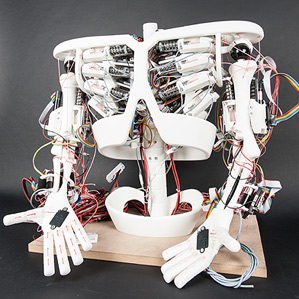Some Robots Are Starting to Move More Like Humans
Robots usually look rigid and nonhuman, with joints engineered to avoid the elasticity that can make their movements less predictable and harder to control. Roboy, a robot developed by Rolf Pfeifer and colleagues in the Artificial Intelligence Lab at the University of Zurich, is an example of a different approach that is slowly gaining momentum.

Roboy has a four-foot-tall human shape and a set of “muscles” inspired by the human musculoskeletal system. The plastic muscles work together via electrical motors and artificial tendons. Tendon-driven systems like Roboy mimic the flexible mechanics of biology, and could result in a new class of robots that are lighter, safer, and move in a more natural way.
“If you’re interested in just getting a job done—in a particular movement or something—then we have traditional methods that are based on motors or joints,” says Pfeifer, who directs the Zurich AI lab. “If you’re interested in more natural kinds of movements, tendon-driven technology needs to be explored.”
Mimicking human movement is ideal for a robot designed to take on human tasks (see “Meet Atlas, the Robot Designed to Save the Day”). But such robots can also help researchers explore how biomechanics can give rise to more intelligent behavior, a field known as embodied intelligence or cognition. “Most people know that intelligence requires the body, but they don’t know why,” says Pfeifer. “I think [Roboy] can be a really interesting research platform for learning in systems with many degrees of freedom.”
Roboy is far from the first tendon-driven robot. An earlier example is Kenshiro, a University of Tokyo robot unveiled last year. Kenshiro is a little larger than Roboy, with 160 pulley-like muscles as well as aluminum bones, which allows it to perform some simple bends and poses. The team behind Kenshiro advised Pfeifer’s team.
A German company called Bionic Robonics offers a tendon-driven system for industrial use. This company’s robotic arm, BioRob, has a flexible mechanical structure that allows it to pick up heavy payloads even though it weighs much less than a conventional robotic arm that the company also makes. BioRob’s light and flexible design also makes it safer to use around human workers. “Although the arm is so compliant, we can do motions that are very fast, very accurate,” says Oskar von Stryk, an engineer behind the robotic arm.
One of the biggest obstacles for tendon-driven engineers is finding a way to effectively model the human body’s complex motions. But it’s also difficult to ensure that the robots can accurately position themselves, as the tendons are prone to slack and stretch. “The calibration of tendons is a challenge for AI research,” explains Sisir Karumanchi, a postdoc in MIT’s Robotic Mobility Group. Engineers often compensate for this with extra sensors.
Pfeifer’s team is already at work on the next iteration of Roboy, which will be larger and contain more motion sensors. Though today’s Roboy cannot walk, the team hopes to change that by making the top half of the body lighter and by using more spring-loaded designs. They also plan to make Roboy’s design open-source, allowing anyone with a 3-D printer to build and tinker with their own version.
Keep Reading
Most Popular
Large language models can do jaw-dropping things. But nobody knows exactly why.
And that's a problem. Figuring it out is one of the biggest scientific puzzles of our time and a crucial step towards controlling more powerful future models.
The problem with plug-in hybrids? Their drivers.
Plug-in hybrids are often sold as a transition to EVs, but new data from Europe shows we’re still underestimating the emissions they produce.
How scientists traced a mysterious covid case back to six toilets
When wastewater surveillance turns into a hunt for a single infected individual, the ethics get tricky.
Google DeepMind’s new generative model makes Super Mario–like games from scratch
Genie learns how to control games by watching hours and hours of video. It could help train next-gen robots too.
Stay connected
Get the latest updates from
MIT Technology Review
Discover special offers, top stories, upcoming events, and more.